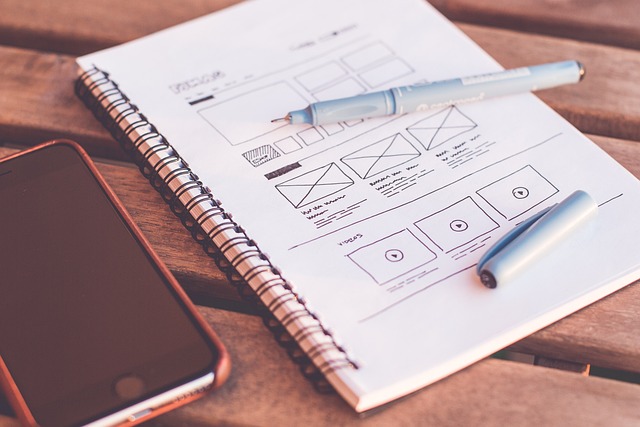In web design, prioritizing user experience (UX) through intuitiveness and enjoyment creates successful digital platforms that boost conversion rates and positive brand associations. Effective navigation, strong visual hierarchy, responsive design, strategic CTA placement, and accessibility are key elements. By integrating these factors, web designers enhance usability, captivate visitors, and drive better website performance in today's diverse digital landscape.
In the dynamic realm of web design, a site’s layout is its backbone, dictating user experience and engagement. This article delves into the intricate elements shaping modern website layouts. We explore how understanding user experience drives design decisions, from key navigation elements to visual hierarchy optimization. Discover the art of responsive design, ensuring seamless viewing across devices, and best practices for Call-to-Action (CTA) placement. Additionally, we shed light on accessibility considerations, making web design inclusive and effective for all users.
Understanding User Experience and Its Impact on Web Layout

In the realm of web design, understanding user experience (UX) is paramount. It’s not just about creating visually appealing websites; it’s about crafting digital spaces that users find intuitive and enjoyable to navigate. UX considerations like site architecture, information hierarchy, and interaction design directly impact how visitors engage with a website. A well-designed UX encourages users to explore further, ultimately driving higher conversion rates and fostering positive emotions towards the brand.
This user-centric approach permeates every aspect of web layout design. From wireframing to prototyping, designers must anticipate user needs and preferences. By incorporating feedback loops and conducting user testing, designers can iteratively refine layouts to ensure they cater to users’ expectations and behaviors. This continuous optimization ensures that the website remains not just functional but also engaging and accessible, ultimately enhancing its overall effectiveness in achieving business objectives.
Key Elements of Effective Website Navigation

In the realm of web design, effective navigation is the linchpin that binds a website’s functionality and aesthetics together. Key elements include a prominent and intuitive menu bar, allowing users to easily explore different sections. Search functionalities are also vital, enabling visitors to find specific content swiftly. Furthermore, well-designed breadcrumbs help users understand their location within the site hierarchy, enhancing overall usability.
Site maps and clear call-to-action (CTA) buttons further streamline navigation. A balanced blend of these elements creates a seamless user experience, encouraging folks to navigate and explore more, thereby boosting engagement and retention in today’s digital era.
Visual Hierarchy: Arranging Content for Maximum Engagement

In effective web design, establishing a strong visual hierarchy is paramount. This involves organizing content in a way that guides users’ eyes naturally through the page, prioritizing information based on its importance and relevance to the user’s goals. By using strategic layout techniques such as contrasting sizes, colors, and font weights, designers can create a clear path for users to follow. This ensures that the most crucial elements—like call-to-actions (CTAs) or key product features—stand out, fostering higher engagement and conversion rates.
A well-structured visual hierarchy not only enhances usability but also improves the overall user experience (UX). It helps users quickly scan the page, find what they need, and take desired actions. In a world where attention spans are shorter than ever, web designers must master this art to captivate visitors and encourage them to explore further, ultimately driving better performance for any website.
Responsive Design: Ensuring Optimal View Across Devices

In today’s digital era, web design has evolved to meet the diverse needs of users across various devices. Responsive design is a crucial aspect that ensures a website optimizes its layout and functionality based on the screen size and orientation of the device being used. This approach allows for a seamless user experience, whether someone is accessing the site on their desktop computer, tablet, or smartphone. By employing flexible grids, flexible images, and media queries, web designers can create layouts that adapt gracefully to different screens.
Responsive design not only enhances accessibility but also improves performance and search engine optimization (SEO). Google, for instance, favors mobile-friendly websites in its search rankings. Moreover, a responsive design reduces the need for separate website versions tailored for each device type, making content management more efficient. As web technologies continue to advance, maintaining a responsive design will remain essential for reaching and engaging users across all platforms.
Best Practices for Call-to-Action (CTA) Placement

In effective web design, Call-to-Action (CTA) buttons play a pivotal role in guiding user behavior and driving conversions. Best practices dictate that CTAs be placed strategically throughout a website, ensuring they stand out yet remain non-intrusive. Typically, these buttons should be positioned at key decision points—above the fold on landing pages, within content sections, and near form submissions or product details. The use of contrasting colors and clear, concise language can significantly enhance their impact, encouraging users to take the desired action.
Additionally, aligning CTAs with user expectations and journey maps is essential. For instance, a “Shop Now” button should be prominent on product pages, while a “Learn More” CTA might suit informational sections. Testing different placements and variations through A/B testing can further optimize their effectiveness, providing valuable insights into what resonates best with your target audience in terms of web design.
Accessibility Considerations in Modern Web Layout Design

In modern web design, ensuring accessibility is no longer an optional consideration—it’s a fundamental aspect that defines effective website layout. With a global online audience, including individuals with disabilities, designers must adhere to inclusive practices. One of the key principles is following Web Content Accessibility Guidelines (WCAG), which provide standards for making digital content accessible to everyone. This includes features like keyboard navigation, alternative text for images, and proper color contrast to aid users with visual impairments.
A well-designed website should be navigable using only a keyboard, benefiting users who rely on screen readers or those who prefer not to use a mouse. Additionally, providing textual alternatives for non-text content, such as graphics and videos, ensures that users with visual impairments can understand the information. These considerations not only enhance user experience but also comply with legal requirements in many jurisdictions, underscoring the importance of accessibility in web design.
